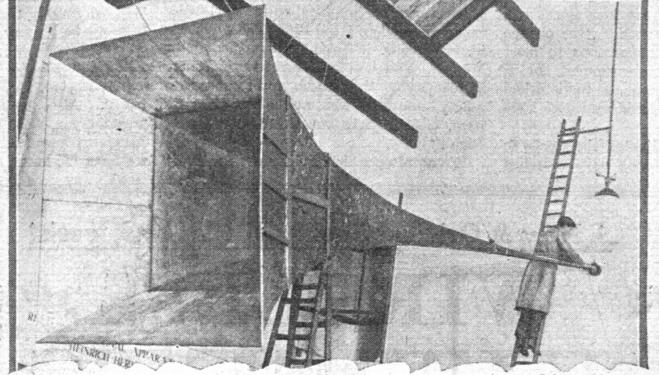
This spring Aleksander Kolkowski has resurrected an extraordinary artefact in the Science Museum’s Virgin Media studio – the UK’s largest ever loudspeaker – and it’s a re-sounding, window-rattling success. The Exponential Horn will be humming with live broadcasts, sound art and fascinating clips from the archives of BBC Radio 3, the Royal College of Music, digital poetry collection Archive of the Now and many more until 20 November 2014.
Measuring over eight metres in length and with an opening that swells to an imposing two metres, the Exponential Horn is an astonishing object. Even more impressive than its sheer size is the quality of sound it produces, which has an almost physical presence and changes entirely when you step to the side of its gaping mouth.
The original horn was built in 1929 by Roderick Denham, who was a curator at the Science Museum in the 1920s and 30s, and an obsessive audiophile. His passion for sound was not confined to his work at the museum: he installed a loudspeaker horn in the roof of his home transforming an upstairs room into a one-of-a-kind sound experience where you could sit within the enormous speaker.
Denham’s colossal horn was a major attraction at the Science Museum and a permanent fixture for ten years, until 1949 when it was damaged beyond repair by a wall that collapsed. It had been silent for well over half a century when Aleksander Kolkowski, the Science Museum’s 2012 Sound Artist in Residence, rediscovered its story. A professional musician and sound researcher who specialises in using historical sound equipment to make exciting new music, Kolkowski was captivated and spent eight months rebuilding the horn according to the original specifications.
The Exponential Horn is a rare treat for the ears and it’s absolutely free, so there’s no reason not to visit the Science Museum and explore the intriguing history of horns, sound experiments, music and spoken word.
Measuring over eight metres in length and with an opening that swells to an imposing two metres, the Exponential Horn is an astonishing object. Even more impressive than its sheer size is the quality of sound it produces, which has an almost physical presence and changes entirely when you step to the side of its gaping mouth.
The original horn was built in 1929 by Roderick Denham, who was a curator at the Science Museum in the 1920s and 30s, and an obsessive audiophile. His passion for sound was not confined to his work at the museum: he installed a loudspeaker horn in the roof of his home transforming an upstairs room into a one-of-a-kind sound experience where you could sit within the enormous speaker.
Denham’s colossal horn was a major attraction at the Science Museum and a permanent fixture for ten years, until 1949 when it was damaged beyond repair by a wall that collapsed. It had been silent for well over half a century when Aleksander Kolkowski, the Science Museum’s 2012 Sound Artist in Residence, rediscovered its story. A professional musician and sound researcher who specialises in using historical sound equipment to make exciting new music, Kolkowski was captivated and spent eight months rebuilding the horn according to the original specifications.
The Exponential Horn is a rare treat for the ears and it’s absolutely free, so there’s no reason not to visit the Science Museum and explore the intriguing history of horns, sound experiments, music and spoken word.
| What | The Exponential Horn, Science Museum |
| Where | Science Museum, Exhibition Road, London, SW7 2DD | MAP |
| Nearest tube | South Kensington (underground) |
| When |
20 May 14 – 20 Nov 14, 10:00 AM – 6:00 PM |
| Price | £Free |
| Website | Click here fore more information via the Science Museum |




